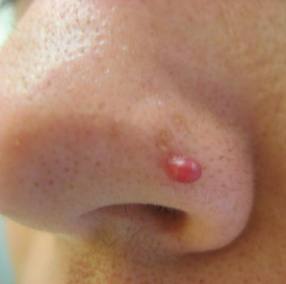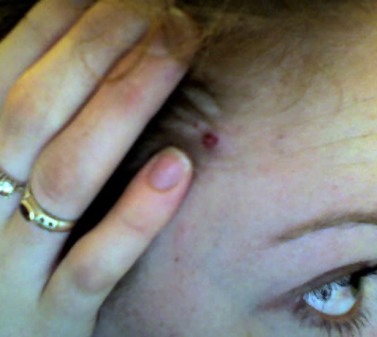
What is a cherry hemangioma and is it the same thing as a strawberry hemangioma? Is it different or the same as a cherry angioma? Are these age spots? Are they a symptom of skin cancer? If you are confused about all these similar-sounding terms and what they mean, you’re not alone. We’ll explain all these terms and tell you a bit about these conditions. You might also want to visit this page to see some pictures of cherry angiomas so you’ll know what those look like.
If you have a skin condition and you’re not sure what is causing it, though, we recommend seeing your doctor or a dermatologist get a diagnosis.

What is a Cherry Hemangioma?
A hemangioma is a non-cancerous (benign) tumor or lesion made of blood vessels or lymph vessels. They are often red in color and are sometimes referred to as cherry for that reason, although they are more often referred to as strawberry hemangiomas. They are often present at birth and may grow smaller or even disappear as people age. They rarely develop in adults. They are found most often on the face and neck.

Cherry angiomas, on the other hand, are small benign growths made of blood vessels. They are generally smaller than hemangiomas and usually only appear in people over the age of 30, although they are occasionally seen in younger people. They can occur anywhere on the body but are most common on the trunk.
Hemangiomas and angiomas are not moles, although people sometimes mistake them for moles. Neither of them is cancerous or a symptom of skin cancer, either.
What Are Red Age Spots?

What people most often refer to as age spots, however, are not cherry angiomas and are not red. The spots most often referred to as age spots are actually lentigines. Sometimes referred to as liver spots, these spots are flat brown spots that range in size from the size of a pencil eraser to the size of a dime. They are usually larger than cherry angiomas and are not red in color. They commonly appear on areas of the body that have been exposed to the sun, like the hands and arms. Age spots usually do not require medical treatment.
How Do You Treat a Cherry Hemangioma or Cherry Angioma?
Cherry angiomas often require no treatment, although doctors usually recommend removing them if they bleed frequently, which sometimes happens. People may also prefer to treat them or have them removed if they dislike the way they look. Doctors usually remove cherry angiomas by cutting them off (excision), freezing them off with liquid nitrogen (cryotherapy), or burning them off (electrocautery). Sometimes laser treatments are used instead.
Cherry hemangiomas often disappear or at least get smaller over time, so sometimes no treatment is needed. However, since they commonly appear on the neck and face, people sometimes want them treated or removed. Sometimes corticosteroids can reduce the inflammation and make them smaller. In other cases, doctors treat them with lasers.
There are also natural treatments that can help remove both cherry angiomas and hemangiomas. Our favorite is a topical treatment from Naturasil. It contains a unique combination of homeopathic remedies and essential oils that work together to reduce inflammation of the blood vessels. This remedy is recommended for both cherry hemangiomas and cherry angiomas. To learn more, just follow this link to the Naturasil Website.
